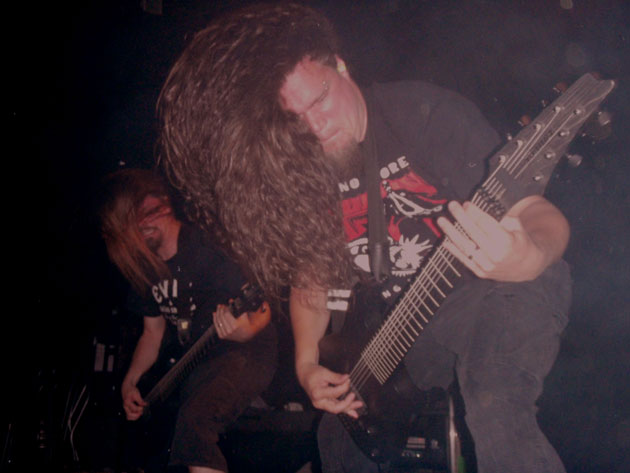
Last month we began to wrestle with time signatures like 5/4 and 7/4 [“Obsessive Progressive: Get a Grip on Odd-Meter Time Signatures”], so in this lesson we’ll push past basic odd-meter patterns and see what it’s like to mix in some 16th-note subdivisions.
So, as the name might suggest, a 16th-note-based time signature is one where the measure is built around groupings of 16th-notes. This is denoted with a 16 as the lower number, so 5/16 means the measure contains five 16th-notes. A time signature of 21/16 means there are 21 16th-notes, and so on. Sixteenth-note time signatures are relatively jarring, but they do occur in progressive music from time to time.
Ex. 1 features a measure of 4/4 followed by two measures of 5/16. I’ve set up my microphone and counted along over the first two passes. What you might notice is that I count to five as a grouping of two and three. This is simply a personal choice—I find it easier to say those numbers out loud.
Ex. 2 is something I composed about a decade ago when studying Dream Theater and Mike Portnoy DVDs. It became apparent that one could think of a complicated-looking time signature like 19/16 as a measure of 4/4 (which contains 16 16th-notes), followed by a measure of 3/16.
I picked up my guitar and stopped thinking about scales and just imagined what Opeth might play, and I quickly came up with the basic rhythm in 4/4 and then expanded it with three 16th-notes. On the repeat, it felt natural to play two groups of three, resulting in a measure of 6/16. Combining a measure of 4/4 and a measure of 6/16 is an easier way to conceptualize a measure of 22/16.
After repeating the first two measures, I end the riff with a measure of 2/4 and a measure of 4/4. Listen closely to the counting so you can feel the pulse before trying to play along.
There are endless ways you can experiment with these combinations of quarter-, eighth-, and 16th-note-based rhythms, but I can’t help but feel they can sound a little forced. Another way to apply these ideas can be described as using polymeters. A polymeter is any setting where you’re stacking different meters on top of each other.
Here’s the concept: As we saw a moment ago, a measure of 4/4 contains 16 16th-notes. That total (16) can be reached in many different ways. Obviously, you could do four groups of four, but you could also do 5-5-5-1, 6-6-4, 3-7-6, etc. Using this approach essentially gives you lots of smaller fragments that will work over 4/4. In Ex. 3, we’re using two groups of five 16th-notes followed by three groups of two 16ths.
The 5-5-2-2-2 subdivision in that last example occurred within a single measure, but it gets a little more exciting when you look at playing ideas over longer sections of music. Ex. 4 spans two measures, so we have 32 16th-notes to play with. Here, I went with a 7-7-7-7-4 grouping. This creates a degree of tension as the music feels like it gets away from the groove until it resolves two measures later.
Here’s a more modern metal-inspired idea (Ex. 5) using just the open-E string. The note is played, then the string is slapped with the left hand before you pick the muted string with the right. This measure is divided up as 2–2–3–3–3–3.
Ex. 6 is similar, but now it stretches across two measures. That long stream of threes helps to create a lot of rhythmic tension that needs resolving. Since this is over such a short period, it’s not too jarring. Take a look at Meshuggah’s “Bleed” to see an example of a simple measure of 3/16 played over drums in 4/4.
[embedded content]
The next example takes inspiration from Tom Monda of New Jersey-based prog rockers, Thank You Scientist. In talking to Tom about his compositional process, he explained that he thinks of ideas like Ex. 7 as rhythmic tension that needs resolving. There’s no real counting involved, though if you were to analyze it, there’s a repeating idea in 19/16 played three times with a six-note riff at the end that implies 7/16—but that’s not how it’s felt at all. If you listen carefully, you’ll notice the drums are obviously in 4/4, which helps to create this polymetric feel.
Ex. 8 expands on the previous example with a one-measure ostinato in 4/4 that plays against the polymetric riff. This results in a phasing effect as the riff shifts against the static ostinato.
Now when you combine the two examples, you get Ex. 9. Try each part alone with a metronome to keep your rhythm chops together. These aren’t for the timid!
As usual, this can be taken to ridiculous extremes. I highly recommend you listen to Ron Jarzombek and his work with Blotted Science to see how progressive you can be with this stuff. Check out this example of Ron demonstrating some of his own polymetric concepts, and I’ll see you next month.
[embedded content]